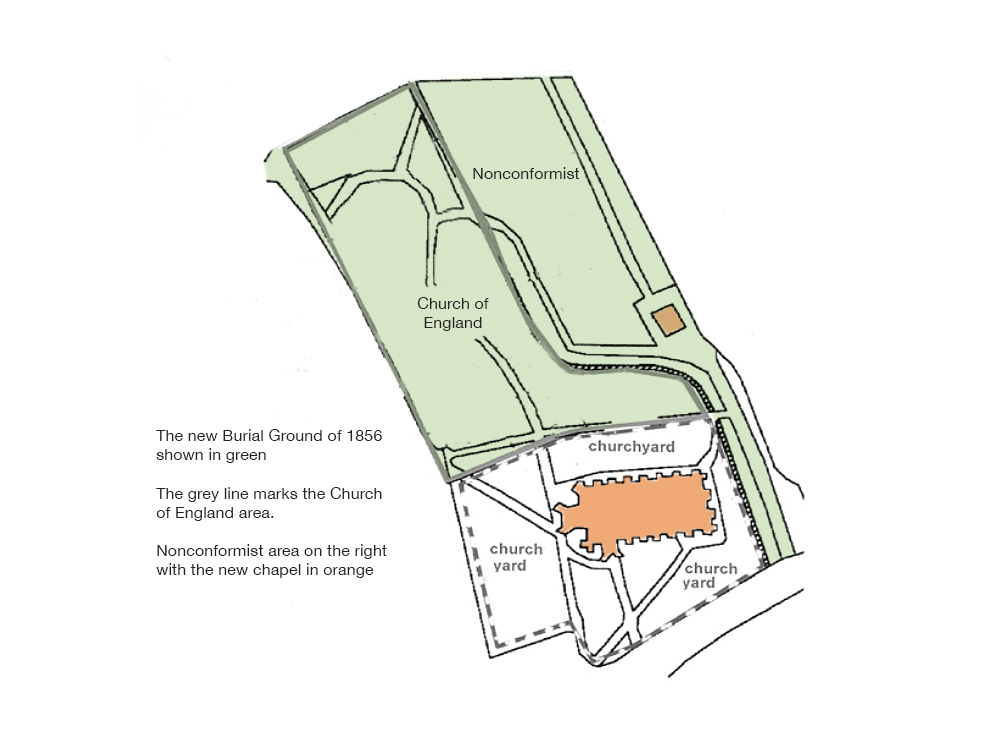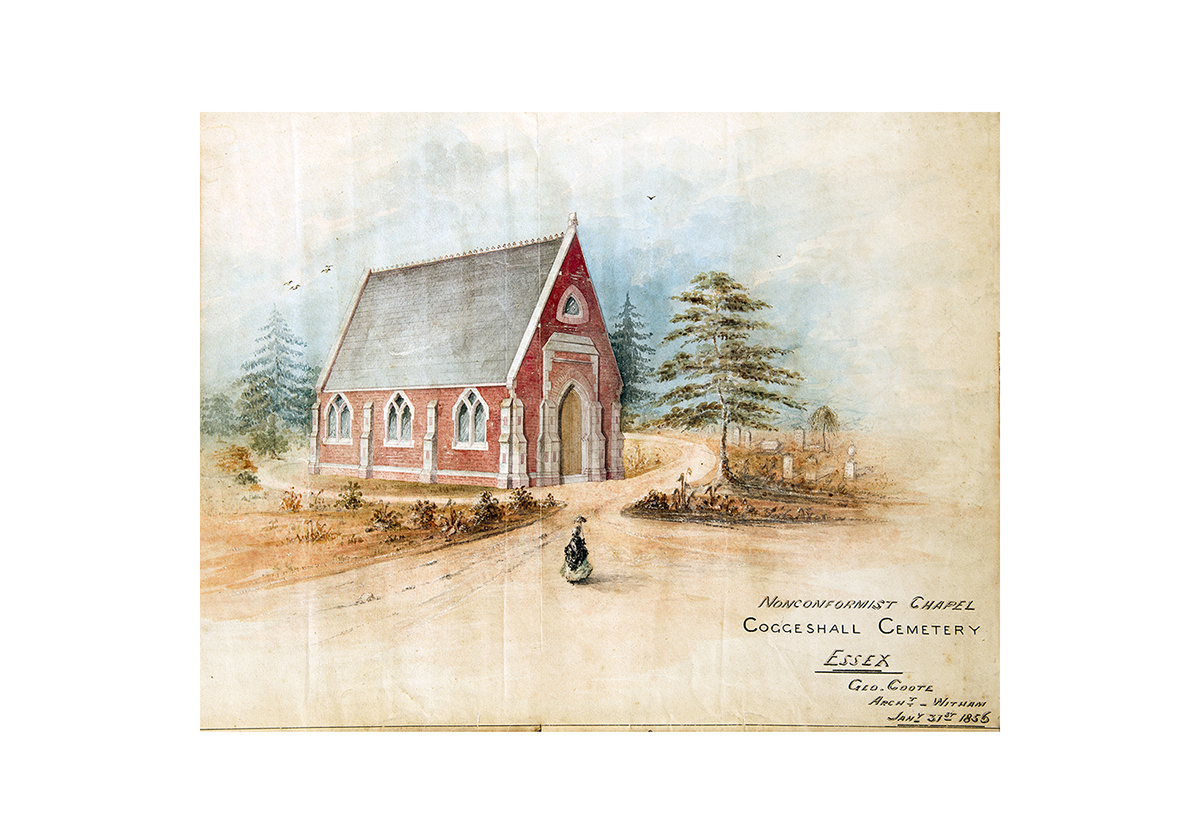THE NONCONFORMIST CHAPEL in the CEMETERY later called THE MORTUARY CHAPEL

Why the Chapel was built
Burial Boards were established by various Acts of Parliament from around 1852 for the purpose of creating and administrating new burial grounds. So with the churchyard at Coggeshall close to capacity and an Order in Council requiring the closure of Coggeshall’s ‘several burial grounds’ on 1st August 1856, there was a need to find a new area suitable for internments.
Several lanowners offered to sell land for the new cemetery including two different plots at Tilkey, one plot on the Braintree Road and one on the Tey Road (which was selected at one point as it was £100 an acre, much cheaper than the others) but the plot finally chosen, three acres of Churchfield offered by Mrs Kimms for £450 was to the north of and adjacent to the existing churchyard.
But there was a disagreement about the details and the two factions – the vestry of St Peter’s church on one side and the nonconformists – the Congregationalists, the Methodists and the Baptists on the other – found themselves at loggerheads. They argued about how the new cemetery was to be divided – what proportion of space should be given to St Peter’s church and how much to the dissenters churches. There was also agument about how the two parts were to be divided, north-south which the dissenters wanted, or east-west as the St Peter’s faction wanted so that their bit of the new cemetary was right next to the old churchyard.

By law the area allocated to each should have been half and half but the St Peter’s faction claimed that this was out of proportion and that based on the actual number of burials over the previous seven year, 69 St Peter’s burials to 28 dissenting burials, a fairer division of the new land should be 60% to 40% . The two factions could not agree even when the burial board received a terse official letter from the Secretary of State seeking an explanation for their lack of action. Eventually the vote went the way of the dissentors but there was much bad feeling and the St Peter’s faction claimed in the newspapers that the result was due to ‘bribery and intimidation’. This wasn’t the end of the disagreements however as some argued that the scheme was too big and too expensive and plans were changed and adjusted but eventually it was muddled through in the traditional way.
(In case you are wondering why there needed to be two parts to the burial ground – this was mostly because the Church of England part had to be consecrated by a priest which meant that it was not acceptable for the dissenters)
Good old Coggeshall!

The Chapel
The site for the new cemetery, adjacent to the parish church, was convenient for funerals from St Peter’s church but was less so for the nonconformists whose various churches were more distant. In such cases it was usual that as part of the cemetery extension scheme, a new chapel should be provided where members of the dissenting churches could hold their funeral services close to the place of internment. The cost of this new chapel together with the purchase of land, the cost of laying access roads, paths, the marking out the plots and fencing the site would be met by a loan provided by central Government.

This is what happened at Coggeshall. Architect George Coote from Witham drew up the plans for the new cemetery and also designed a Nonconformist Chapel (as he called it) to be erected on that part of the cemetary set aside for nonconformists. His drawing of the proposed building is shown above.
Tenders were invited and in October 1855 the board accepted the quote from Brown of Bocking of £248 to build the chapel and £179 for fencing the site. A loan of £1,500 would pay for the scheme.
Similar chapels were built at this time right across the country where new cemetaries were established distant from existing church buildings and equally for the established church as for the independant churches and it was not unusual for two chapels were built.
The Coggeshall chapel was probably completed in 1857. We know that sometimes the congregation exceeded the space available and people would have to stand outside during the service. Funerals of significant nonconformists were sometimes conducted in the parish church with the permission of the incumbant especially when it was clear that the number of people expected exceeded the capacity of the chapel – Dick Nunn’s funeral for example took place in St Peter’s church and was conducted by the Rev Philips of the Congregational church.
The name now used for the building, ‘Mortuary Chapel’, does lead to some confusion – the Coggeshall Chapel was a building used for funerals and so far there is no evidence that coffined bodies were kept there prior to a funeral (which is another meaning for the same phrase). The name was first used of the Coggeshall chapel in 1897 for the funeral there of a Coggeshall shopkeeper, Mr Gowers.
When the Coggeshall parish council was created in 1894 it took over the responsibilities of the burial board so the chapel is now their responsibility.
The chapel has fallen into disrepair, it has been fenced off and it’s future is uncertain. Efforts to find a new use for the building have been so far been unsucessful.
Trevor Disley October 2024
Sources- Local newspaper reports and parish council minute books in the Essex Record Office.
David Munday our ‘Wandering Ponderer’ did a report based on this research and the parish council responded-
Please be rest assured that the Chapel is very important to the Parish Council, who are its custodians. Councillors are in the early stages of working on a project of restoration, but it will be a long road. We have the potential to be able to fund a substantial part of the works from a ‘pot’ of developer contributions, but it will also need further grant funding to cover it all, and how long it will be before all the funding arrives from development is not certain – it could be another 2 years or so. In the meantime, we are looking after it as best we can (e.g. the roof tiles were repaired last year), and we are monitoring its condition. We are all looking forward to its restoration and a new life for it back in the community.